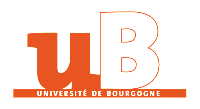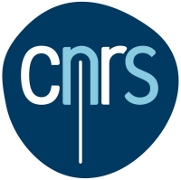Conference
Perverse Sheaves and Applications
April 7-8 2015
Institut de Mathématiques de Bourgogne ~ DIJON
Program
The workshop will be centered around the following two mini-courses
-
Introduction to Mixed Hodge Modules
by C. SABBAH (École Polytechnique) and D. MÉGY (Univ. Lorraine)
Abstract
The goal of these two lectures is to give an overview on Morihiko Saito's theory of Mixed Hodge modules. Categories of Mixed Hodge modules
on complex manifolds are abelian categories which satisfy the formalism of six functors and the formalism of weights. Very roughly, a mixed
Hodge module is a perverse sheaf with a mixed Hodge structure. The lectures will explain the global structure of these categories and
introduce the main properties of Mixed Hodge Modules that will be used in the lectures of Chris Peters.
-
The role of algebraic tori in the Baily-Borel compactifications: Hodge and group theoretic aspects.
by C. PETERS (TU Eindhoven)
Abstract
A (fine) moduli space of principally polarized abelian varieties carries a universal family whose
first cohomology defines a variation of weight one Hodge structures. It is an example of a homogeneous
variation on a Shimura domain. In the Baily-Borel compactification boundary components must be added
isomorphic to moduli spaces for lower dimensional abelian varieties.
The structure of the compactification near such a boundary can be described as the blow down of a
very simple toric compactification associated to a canonical toric fibration over that component.
This reveals how the underlying local system extends to the boundary as a (twist of a) perverse sheaf,
called the "homogeneous boundary sheaf".
Its cohomology is again locally constant and is directly related to group cohomology of the parabolic
group which stabilizes the boundary component. This description
does not suffice to put mixed Hodge structures on these cohomology groups.
One has to blow up the boundary to a smooth toroidal compactification and study the degenerating Hodge
structure when it tends towards the boundary in this compactification. Since mixed Hodge modules behave
well in a functorial way, these form a good tool to handle the passage to toroidal compactifications.
It turns out that what happens on the cohomology sheaves can be understood on the toric varieties
forming the fibre of the blow up (from Baily-Borel to toric compactification). Let me call
these "toric blow up fibers".
This, together with Saito's machinery, then puts the structure of a mixed Hodge module on the
homogeneous boundary sheaf. Its cohomology gives variations of pure Hodge structures on the Baily-Borel boundary.
Clearly, only a part of this vast program can be covered in 2 lectures. I shall concentrate on the cohomological
aspects that can be understood with help of the toric blow up fibers.
and a series of research talks :
-
Relative motives of Abelian type and conservativity of realizations
J. WILDESHAUS (Univ. Paris 13)
Abstract
The first part of the talk will introduce the category of relative motives
(or motivic sheaves) of Abelian type over a base. For example, if the
base equals a (fine) moduli space of Abelian varieties, or one of its
(Baily-Borel or toroidal) compactifications respectively, then certain of these
relative motives realize to give the variations of weight one Hodge structure
considered in PETERS' talk, or their direct images in the compactification,
respectively.
In the second part, a recent result on conservativity of realizations,
when restricted to motives of Abelian type, will be explained. It says that
there are no non-zero "phantoms" among these motives, i.e., such a motive
is zero as soon as its realization is. Depending on how much time is left,
a considerably stronger version of this result will be mentioned: the realization
of a motive of Abelian type not only respects, but detects the weights present
(or absent) in the motive. This means in particular that the weights of the
motives occurring naturally in the context of moduli spaces of Abelian varieties
can be read off the underlying Hodge modules, i.e., the formula that will be
discussed in PETERS' talk.
-
Enriched Hodge Structures on thickenings of complex analytic varieties
D. PATEL (IHES)
Abstract
Bloch and Srinivas defined a category of enriched Hodge structures
in order to capture cycle classes on projective but possible singular varieties. In this talk,
after recalling some background, we shall explain a construction of enriched Hodge structures
(and, in particular, mixed Hodge structures) on thickenings of complex analytic varieties. If there is time,
we shall also discuss some applications to algebraic cycles. This is based on joint work with Madhav Nori.
Participants
- J. Bouali (Dijon)
- A. Dubouloz
- P. Eyssidieux (Grenoble I)
- D. Faenzi (Dijon)
- L. Fu (Lyon )
- P. Gatti (KU Leuven)
- I. Goncalves (Stockholm)
- Z. Jiang (Paris 7)
- D. Patel (IHES)
- A. Perego (Nancy)
- C. Peters (Eidhoven)
- C. Petitjean (Dijon)
- J. Pons (Barcelona)
- J. de Ronde (Amsterdam)
- C. Sabbah (Polytechnique)
- L.E. Saumell (KU Leuven)
- M. Toma (Nancy)
- E. Wagner (Dijon)
- J. Wildeshaus (Paris 13)
Schedule
| Tuesday |
Wednesday |
Welcome Coffee
10:00-10:30
|
SABBAH
09:00-10:30
|
MÉGY
10:30-12:00 | Coffee Break |
PATEL
11:00-12:00
|
Lunch break
|
PETERS I
14:00-15:30
|
PETERS II
14:00-15:30
|
Coffee Break
|
WILDESHAUS
16:00-17:00
|
Conference dinner
19:30
|
Practical Informations
Our sponsors
 Johannes NAGEL
Johannes NAGEL  Damien MÉGY
Damien MÉGY 




